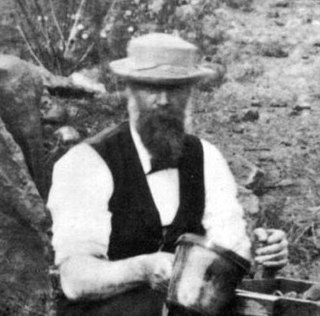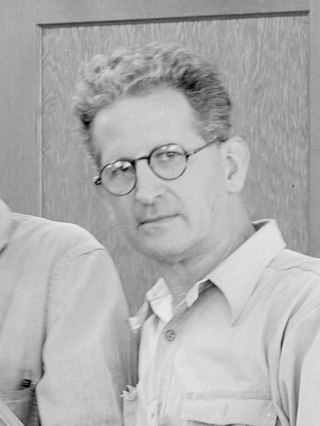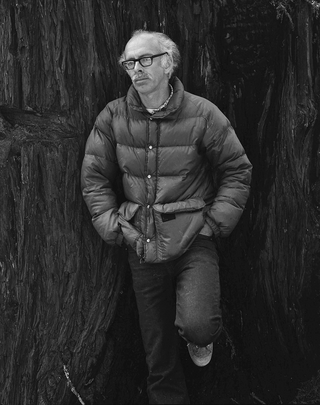
Half Dome is a quartz monzonite batholith at the eastern end of Yosemite Valley in Yosemite National Park, California. It is a well-known rock formation in the park, named for its distinct shape. One side is a sheer face while the other three sides are smooth and round, making it appear like a dome cut in half. It stands at nearly 8,800 feet above sea level and is composed of quartz monzonite, an igneous rock that solidified several thousand feet within the Earth. At its core are the remains of a magma chamber that cooled slowly and crystallized beneath the Earth's surface. The solidified magma chamber was then exposed and cut in half by erosion, therefore leading to the geographic name Half Dome.

Ansel Easton Adams was an American landscape photographer and environmentalist known for his black-and-white images of the American West. He helped found Group f/64, an association of photographers advocating "pure" photography which favored sharp focus and the use of the full tonal range of a photograph. He and Fred Archer developed a system of image-making called the Zone System, a method of achieving a desired final print through a technical understanding of how the tonal range of an image is the result of choices made in exposure, negative development, and printing.
Galen Avery Rowell was an American wilderness photographer, adventure photojournalist and mountaineer. Born in Oakland, California, he became a full-time photographer in 1972.
Pure photography or straight photography refers to photography that attempts to depict a scene or subject in sharp focus and detail, in accordance with the qualities that distinguish photography from other visual media, particularly painting. Originating as early as 1904, the term was used by critic Sadakichi Hartmann in the magazine Camera Work, and later promoted by its editor, Alfred Stieglitz, as a more pure form of photography than Pictorialism. Once popularized by Stieglitz and other notable photographers, such as Paul Strand, it later became a hallmark of Western photographers, such as Edward Weston, Ansel Adams and others.

Color photography is photography that uses media capable of capturing and reproducing colors. By contrast, black-and-white or gray-monochrome photography records only a single channel of luminance (brightness) and uses media capable only of showing shades of gray.

Carleton E. Watkins (1829–1916) was an American photographer of the 19th century. Born in New York, he moved to California and quickly became interested in photography. He focused mainly on landscape photography, and Yosemite Valley was a favorite subject of his. His photographs of the valley significantly influenced the United States Congress' decision to preserve it as a National Park.

Fine-art photography is photography created in line with the vision of the photographer as artist, using photography as a medium for creative expression. The goal of fine-art photography is to express an idea, a message, or an emotion. This stands in contrast to representational photography, such as photojournalism, which provides a documentary visual account of specific subjects and events, literally representing objective reality rather than the subjective intent of the photographer; and commercial photography, the primary focus of which is to advertise products or services.

Born Free and Equal: The Story of Loyal Japanese-Americans is a book by Ansel Adams containing photographs from his 1943–1944 visit to the internment camp then named Manzanar War Relocation Center in Owens Valley, Inyo County, California. The book was published in 1944 by U.S. Camera in New York.
John Sexton is an American fine art photographer who specializes in black and white traditional analog photography.

George Cedric Wright was an American violinist and a wilderness photographer of the High Sierra. He was Ansel Adams's mentor and best friend for decades, and accompanied Adams when three of his most famous photographs were taken. He was a longtime participant in the annual wilderness High Trips sponsored by the Sierra Club.

Moonrise, Hernandez, New Mexico is a black-and-white photograph taken by Ansel Adams, late in the afternoon on November 1, 1941, from a shoulder of highway US 84 / US 285 in the unincorporated community of Hernandez, New Mexico. The photograph shows the Moon rising in a dominating black sky above a collection of modest dwellings, a church and a cross-filled graveyard, with snow-covered mountains in the background. Adams captured a single image, with the sunset lighting the white crosses and buildings. Because Adams did not date the image, attempts have been made to determine a date from astronomical information in the photograph. It is one of Adams' most popular works.
Parmelian Prints of the High Sierras is a portfolio of 18 silver gelatin photographic prints made by Ansel Adams in 1927. It was the first publication of a portfolio of his prints, produced not long after he decided to become a professional photographer, and has since been called "a landmark work in twentieth-century photography."
Dugan Aguilar (1947–2018) was a Native American photographer whose work has been exhibited by major museums. He is "among the first Native photographers to document Native life in Yosemite and California through his own vision."

Dody Weston Thompson was a 20th-century American photographer and chronicler of the history and craft of photography. She learned the art in 1947 and developed her own expression of “straight” or realistic photography, the style that emerged in Northern California in the 1930s. Dody worked closely with contemporary icons Edward Weston, Brett Weston and Ansel Adams during the late 1940s and through the 1950s, with additional collaboration with Brett Weston in the 1980s.
Rondal Partridge was an American photographer. After working as an assistant to well-known photographers Dorothea Lange and Ansel Adams in his youth, he went on to a long career as a photographer and filmmaker.
Friends of Photography was a nonprofit organization started by Ansel Adams and others in 1967 to promote photography as a fine art. During its existence the organization held at least 330 photography exhibitions at its galleries in Carmel and San Francisco, California, and it published a lengthy series of monographs under the name Untitled.The organization was formally dissolved in 2001.

Ray McSavaney was an American fine-art photographer based in Los Angeles, California. Throughout a spartan but active life, practicing classical Western black and white fine art photography, he made enduring photographs of buildings, bridges, and street scenes of the vast city, ancient ruins and panoramic vistas of the Southwest, and studio setups with varied floral subjects. He died from lymphoma in Los Angeles Veteran's Hospital. Warm tributes to his life and career by some of his close friends and colleagues appear in a ‘celebration of life’ memorial recounted in ‘View Camera’ magazine.
Rebecca A. “Becky” Senf is an American writer, and curator working in the field of photography. She is the Chief Curator at the Center for Creative Photography (CCP). She joined the CCP as Norton Family Assistant Curator in 2007, which was a joint appointment with Phoenix Art Museum, and was promoted to Chief Curator in 2016.

Lodgepole Pines, Lyell Fork of the Merced River, Yosemite National Park is a black-and-white photograph taken by Ansel Adams in 1921. It is one of the photographs that he took at the beginning of his career, when he was following pictorialism, a style inspired by painting, that he soon would abandon for a more realistic approach to photography. This photograph with the title A Grove of Tamarack Pine was included in his Parmelian Prints of the High Sierras portfolio, published in 1927, and its also known by that name.

Clearing Winter Storm, Yosemite National Park, California is a black and white photograph taken by Ansel Adams, c. 1937. It is part of a series of natural landscapes photographs that Adams took from Inspiration Point, at Yosemite Valley, since the 1930s.












